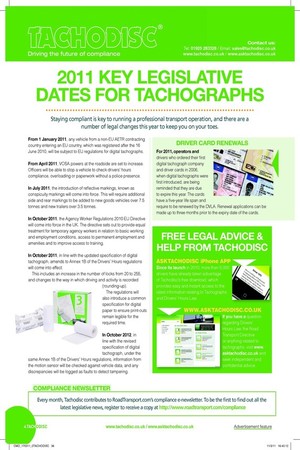2011 KEY LEGISLATIVE DATES FOR TACHOGRAPHS
Page 26

If you've noticed an error in this article please click here to report it so we can fix it.
Staying compliant is key to running a professional transport operation, and there are a number of legal changes this year to keep you on your toes.
From 1 January 2011, any vehicle from a non-EU AETR contracting country entering an EU country, which was registered after the 16 June 2010, will be subject to EU regulations for digital tachographs.
From April 2011, VOSA powers at the roadside are set to increase. Officers will be able to stop a vehicle to check drivers’ hours compliance, overloading or paperwork without a police presence.
In July 2011, the introduction of reflective markings, known as conspicuity markings will come into force. This will require additional side and rear markings to be added to new goods vehicles over 7.5 tonnes and new trailers over 3.5 tonnes.
In October 2011, the Agency Worker Regulations 2010 EU Directive will come into force in the UK. The directive sets out to provide equal treatment for temporary agency workers in relation to basic working and employment conditions, access to permanent employment and amenities and to improve access to training.
In October 2011, in line with the updated specification of digital tachograph, amends to Annex 1B of the Drivers’ Hours regulations will come into effect.
This includes an increase in the number of locks from 20 to 255, and changes to the way in which driving and activity is recorded (rounding-up).
The regulations will also introduce a common specification for digital paper to ensure print-outs remain legible for the required time.
In October 2012, in line with the revised specification of digital tachograph, under the same Annex 1B of the Drivers’ Hours regulations, information from the motion sensor will be checked against vehicle data, and any discrepancies will be logged as faults to detect tampering.


















































